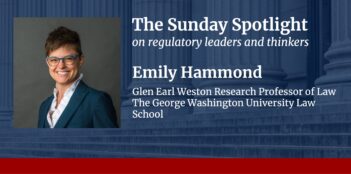
Critics argue that a federal regulator’s failure to address climate change clashes with the goal of efficient markets.
The Federal Energy Regulatory Commission (FERC) is an independent, bipartisan agency tasked with ensuring that wholesale energy rates are “just and reasonable.” But how can energy prices be just or reasonable when they fail to factor in the social and environmental cost of carbon emissions?
That is the precise question asked by a growing chorus of academics and practitioners. Over the past few years, legal scholars have argued that the Commission can and should do more to regulate carbon emissions—for example, by imposing a “carbon adder” on wholesale electricity rates. The Energy Bar Association even opened a recent conference with a lively debate over the role for carbon costs in FERC regulation.
Any attempt by the Commission to regulate carbon directly would mark an unusually bold intervention for an agency with a reputation as a staid and technocratic arbiter of ratemaking disputes. But some scholars argue that carbon regulation falls squarely within the Commission’s statutory authority and may even be necessary to fulfill the agency’s responsibility to ensure competitive, well-functioning energy markets.
The Federal Power Act of 1920 granted the Federal Power Commission—now FERC—authority over interstate wholesale energy markets. The agency’s regulatory reach thus extends to any energy that is sold for resale and passes through the interstate transmission system.
The 1920 Act entrusts the Commission with ensuring “just and reasonable” wholesale energy rates and preventing “undue discrimination” by public utilities against market participants. Although the law does not define “just and reasonable,” the U.S. Court of Appeals for the D.C. Circuit has clarified, perhaps not so helpfully, that the Commission must set rates “within a zone of reasonableness”—suggesting that the agency retains broad discretion to define for itself what counts as just and reasonable.
According to Bethany Davis Noll and Burcin Unel of the Institute for Policy Integrity, the Commission has embraced “market efficiency” as the primary measure of just and reasonable rates. It relies on market mechanisms to set wholesale energy prices, and its regulatory agenda is mainly aimed at promoting competition and economic efficiency in energy markets.
The problem, Davis Noll and Unel say, is that energy markets have completely failed to account for the environmental and social cost of carbon emissions. Despite clear evidence linking carbon emissions to climate change, and then connecting climate change to a host of social and environmental harms, those harms are not reflected in the wholesale price of high-carbon energy. Instead of being factored into pricing decisions, the cost of carbon is externalized onto society—a classic market failure.
Given FERC’s obsession with promoting economic efficiency, its reluctance to address such a glaring inefficiency is puzzling, Davis Noll and Unel argue. Like others before them, they suggest that an agency-imposed surcharge on the wholesale price of high-carbon energy—a “carbon adder”—could be a workable fix.
Some commentators, though, have suggested that the Commission lacks statutory authority to intervene in wholesale energy markets to promote environmental goals. John Moot, a partner at Skadden, Arps, Slate, Meagher & Flom LLP, has argued that the Commission cannot “pick winners and losers by choosing sides in the climate change debate” by imposing a price on carbon.
Although the Federal Power Act explicitly allows FERC to consider the environmental impact of hydropower facilities, Moot argues that it does not grant the agency the same authority over fossil fuel generators. Moreover, the Act bars the Commission from “direct regulation of generating facilities.” A carbon adder applicable to all generators would thus be “a jurisdictional bridge too far,” according to Moot.
By contrast, Joel Eisen of the University of Richmond School of Law contends that the Commission’s authority under the Federal Power Act should be interpreted expansively as enabling the agency to pursue any and all environmental policies that directly relate to wholesale energy rates. Other scholars agree that the agency could plausibly impose a carbon adder to wholesale rates under its existing authority.
Practically speaking, however, FERC’s failure to address the environmental impact of carbon emissions is likely more about politics than any statutory limitation on the agency’s authority. In recent years, the Commission has often found itself frozen in partisan deadlock or lacking a quorum for long periods of time. Key decisions increasingly have split along predictable party lines, with the agency’s Democrats favoring a more active role in fighting climate change and its Republicans opposed.
For his part, Commission Chair Neil Chatterjee has stated that he believes climate change is real and that “we need to take steps to mitigate emissions urgently.” But Chatterjee has still shied away from using the Commission’s authority for such purposes, refusing, for example, to consider greenhouse gas emissions when assessing the environmental impact of natural gas pipelines.
Climate policies, such as a carbon adder, could be perceived to interfere with the Trump Administration’s widely publicized goal of resuscitating economically-ailing coal plants.
A carbon adder would also surely force FERC into the public eye, a position it has traditionally avoided. But, whether its commissioners like it or not—given the importance of energy policy to the climate agenda—the Commission is almost certain to find itself increasingly in the spotlight in the years ahead.



